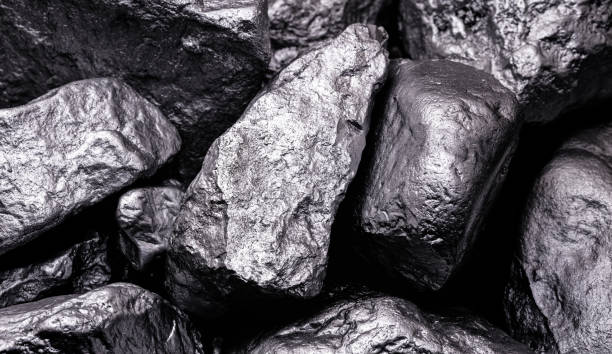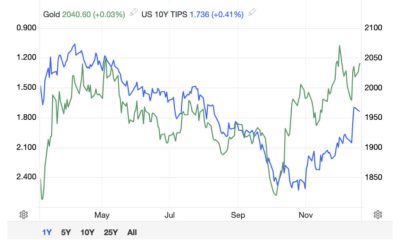Energy & Critical Metals
Manganese: The ‘Forgotten’ Battery Metal
By Luke Holland Often overlooked in the wider grouping of the battery metals, manganese is…

By Luke Holland
Often overlooked in the wider grouping of the battery metals, manganese is beginning to find its voice and draw attention from investors. This critical metal is a key component in the production of lithium-ion batteries and a focal point in the nickel-manganese-cobalt battery technology. In March 2023, the EU released its updated list of critical minerals, in which manganese holds centre stage, with the old reliable copper and nickel metals for company. The battery metal grouping has somewhat been drowned out by the sharp rises and falls of a few of its collectives, most notably lithium.
It is commonplace that lithium is the first commodity on the tip of investors tongues once the topic of battery metals is broached. However, the oversight of manganese may be a costly mistake. Andrew Zemek, a senior analyst with CPM Group, explains how there is no shortage in supply of the bulk commodity, the choke point occurs when you look at battery grade High Purity Manganese (HPM). Zemek further elaborates on the criticality of HPM in the production of EV batteries, particularly nickel-manganese-cobalt batteries. HPM is derived from a highly refined form of manganese metal. The high purity manganese sulphate is challenging and expensive for producers to meet. Zemek further remarks “high purity manganese is not a commodity like copper or gold – purity is king.”
Jurisdictions the world over are grappling with the urge to attain reliable supply chains of critical raw materials, no more so than those related to the battery metals. The EU, in particular, is feeling the heat in relation to security of supply. Having been placed somewhat between a rock and a hard place, the EU must obtain reliable supply, whilst also adhering to its own strict ESG guidelines. For this reason, battery raw materials must comply with increasingly stringent criteria. As a result, auto manufacturers are under further pressure to engineer every gram of these precious raw materials out of the current sluggish supply lines.
As of 2023, several major automakers have committed to the production of manganese-based batteries, included in this grouping are European juggernauts, Volkswagen and Renault with Japanese counterparts Nissan and Mitsubishi. Elon Musk’s Tesla brand, too, finds itself amongst this cohort. Collectively, millions of cars are to be produced each year, all of which will require high purity manganese (HPM). Given this trend, demand for relatively inexpensive high purity manganese is expected to grow, due to the vast ramp up in production of manganese-based batteries.
Presently, when investors discuss battery metals, every other speculator can recite the issues and shortages associated with lithium, graphite and cobalt; however, this is not the case with manganese. Being right at the heart of NMC battery production, some analysts such as Sam Jaffe, of Cairn Energy Research Advisors forecasts the demand for high purity manganese will increase at a ten-year compound annual growth rate of 33.6%, the highest growth for any battery metal.
In 2021, industry estimates reflect HPM demand was running at 150,000 tonnes per annum, which is now forecast to exceed 1Mtpa by 2040 according to some industry players. The forecast is based on current EV Battery chemistry, coupled with the ongoing pro manganese battery trend, which is seeing the new generations of batteries favouring the use of manganese in its design.
Manganese in particular, being a bulk commodity, is relatively easy to extract and readily available, and has been somewhat fobbed off as less important. This lack of foresight is something investors would do wise to remedy. CPM Group reports in 2022 that 98% of high purity manganese was produced in China which accounts for 92% of the world’s processing capacity for this product.
Presently, most manganese comes from South Africa, Ghana, Gabon, Brazil, and eastern Europe, all of which have their own geopolitical issues of late, lending further concerns surrounding supply. CPM Group’s Andrew Zemek, forecasts “a total of 103 new projects of average size by today’s standards are required to meet the expected HPM demand. At present, 15 of these projects are in the pipeline, 9 of which are located in China”. This is a testament Zemek further elaborates on how forgotten this critical metal is.
The EU’s hopes of establishing a domestic supply of the elusive HPM, presently relies on the advancement of a handful of realistically attainable projects. One such project is the Chvaletice manganese project operated by Euro Manganese [EMN-TSXV; ASX]. Located 90 km east of the Czech Republic’s capital of Prague, this project is at the forefront of the EU’s critical minerals plan.
What’s interesting about this project is that it is not a conventional mining opportunity, but a recycling one. Euro Manganese plan to recycle an old mine tailings deposit which has been laying idle for the past several decades. The deposits hosts Europe’s largest manganese resource, and will produce approximately 49,000 tonnes HPM per annum, whilst simultaneously rehabbing historic workings. Euro Manganese established a processing plant on site in 2018 and successfully produced battery grade HPM, making the Chvaletice project Europe’s most realistic chance of achieving a reliable domestic supply of this critical raw material.
However, a sole project alone will not suffice in the short term and one thing is clear, a supply of HPM concentrate from a reliable jurisdiction is very much sought after by the market. One such jurisdiction is Australia, having been a staple for the mining industry in the past and could yet hold the answer to the manganese supply question in the future. A plethora of companies at present are chasing the elusive HPM goal. Firebird Metals [FRB-FSX] is one such junior which has come out of the blocks strong. Firebird Metals owns and operates the Oakover project in Western Australia consisting of 360 km2 of manganese-rich ground. In 2023, Firebird confirmed that manganese from their Oakover project can be processed into HPM suitable for battery grade manufacture, following extensive trials.
Joining Firebird for company in the manganese market is Element 25 [E25-ASX]. Amply named after the battery metal’s position on the periodic table, Element 25, lays claim to the Butcherbird project, Australia’s largest inland manganese resource. Located in the Pilbara in WA, Butcherbird boasts a resource of 263 million tonnes. In April of this year, Element 25 released a feasibility study into a high purity manganese processing facility which would convert the manganese ore extracted at the Butcherbird project into high purity manganese sulphate required for the battery market. In addition, this facility is planned to be located in the US state of Louisiana, yielding a vast opportunity to tap into the ever-growing US EV market.
The demand for battery metals and importance of manganese within this sector for use in electric vehicles (EVs) continues to grow, with manganese forming an essential element within the battery cathode industry. Top car manufacturers, having already commenced works to secure supply chains by partnering with battery metal producers, provides confidence that the growth of the battery metals inclusive of manganese is set to rise further. With an estimated 90 kg of manganese being utilized in the average electric car. Further work and investment are required to meet the soaring demand in the coming decade.

Uranium Exploration Company Announces Additional Staking in the Athabasca Basin
Source: Streetwise Reports 12/22/2023
Skyharbour Resources Ltd. announced an update from its Canada-based Falcon Project along with additional…
Tesla Launches New Mega Factory Project In Shanghai, Designed To Manufacture 10,000 Megapacks Per Year
Tesla Launches New Mega Factory Project In Shanghai, Designed To Manufacture 10,000 Megapacks Per Year
Tesla has launched a new mega factory…
Giving thanks and taking stock after “a remarkable year”
An end-of-year thank you to our readers, industry colleagues and advertisers before Electric Autonomy breaks from publishing until Jan. 2
The post Giving…


















